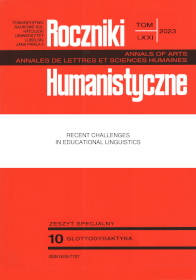There Is More to Learning Words than Meets the Conscious Eye
There Is More to Learning Words than Meets the Conscious Eye
Author(s): Konrad SzcześniakSubject(s): Language and Literature Studies, Applied Linguistics, Language acquisition
Published by: Towarzystwo Naukowe KUL & Katolicki Uniwersytet Lubelski Jana Pawła II
Keywords: conscious attention; formulaic language; use-based language acquisition
Summary/Abstract: This study focuses on the role of attention in learning new language items. These include elements of varying size and schematicity, ranging from single morphemes, through words, phrases, partially-filled sequences, to entirely schematic grammatical patterns. Following cognitive-linguistic usage-based models, it is assumed that language learning takes place by observing examples of use found in the input and whose elements must be memorised. Given the nature of linguistic use and the deluge of information to which the learner is exposed at any moment, learning is highly unlikely to involve only a continuous focus of consciousness. Thus, the present contribution argues against the main claims of Richard Schmidt’s Noticing Hypothesis, under which learning is only possible when consciously attending to input elements. On the contrary, the development of proficiency is based mainly on unconscious learning mechanisms. The acquisition of phraseological compounds is particularly dependent on incidental learning.
Journal: Roczniki Humanistyczne
- Issue Year: 71/2023
- Issue No: 10S
- Page Range: 139-154
- Page Count: 16
- Language: English

